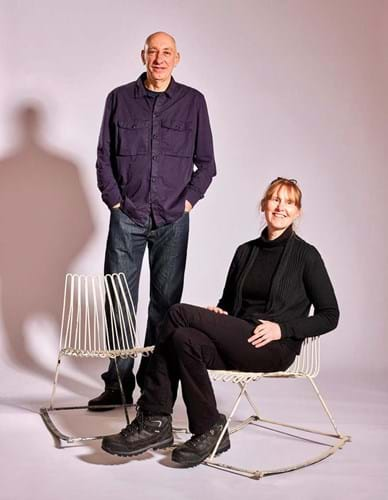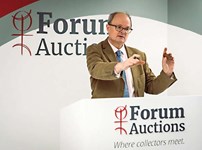
Peter and Laura Wells of Form & Function pictured with the pair of Ernest Race Kangaroo rocking chairs.
Dealer Peter Wells, trading as Form & Function in Brighton, was hopping with joy when an article in ATG finally led him to a pair of Kangaroo chairs by Ernest Race (1913-64).
Wells featured in ATG’s 5 Questions in Dealers’ Diary (issue 2323) in 2018 where he stated his desire to find this rare model by the British furniture designer. The article was spotted by a friend of a lady in Lincoln who happened to own a pair of the rare 1950s designed rocking chairs.
She acquired them in the 1980s when she worked as a billboard artist in a workshop in Chiswick above a stove enameller who subcontracted for Race in the 1950s.
The bent steel chair is famous among Mid-century design specialists and was the cover image of the book Austerity to Affluence: British Art and Design, 1945-62 published in 1997.
Time and Life Building
Race created the design for Michael Rosenauer’s Time and Life Building on Bond Street in 1953.
A set was made for the terrace and sat alongside a reclining figure by Henry Moore. Race, who named several designs after animals, took inspiration from the structure of the grill tray of a gas cooker. The chairs were formed from one continuous length of steel rod approximately 45ft long, which was cold bent on a jig.
Unlike Race’s Antelope chair, designed for the Festival of Britain in 1951, the Kangaroo chair never went into commercial production.
Wells believes just 11 examples were made and the V&A states there are only two in existence (one in private hands, one at the V&A) but with Wells’ pair that makes four.
Wells said: “I think I have the only pair. I don’t think I will get anything as rare again. It is all down to ATG for helping me find them.”
He added: “I like to celebrate Mid-century British design as opposed to just Danish or Scandinavian. I believe this design is up there with Robin Day’s Festival Hall chair. This is high design and such a seminal work of the Festival of Britain era.”
Wells spent three years negotiating with the vendor and has finally managed to buy them.
He plans to sell the pair for a five-figure sum but first plans to arrange a visit to the Time and Life building to photograph them on the terrace they were designed for.















